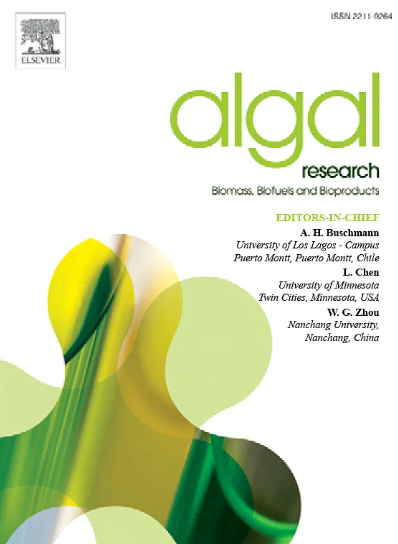Hydrolysis and characterization of bioactivity and functionality properties of protein fractions from Spirulina platensis and Sargassum illicifolium for active shrimp preservation
IF 4.6
2区 生物学
Q1 BIOTECHNOLOGY & APPLIED MICROBIOLOGY
Algal Research-Biomass Biofuels and Bioproducts
Pub Date : 2025-06-18
DOI:10.1016/j.algal.2025.104144
引用次数: 0
Abstract
Marine algae are promising sources of bioactive proteins, but their functional potential remains underexplored. Developing natural preservatives for seafood (e.g., shrimp) is critical to replace synthetic additives and address spoilage during cold storage. This study aimed to (1) produce bioactive peptides from Spirulina platensis and Sargassum ilicifolium via enzymatic hydrolysis using Alcalase, Protamex, Pancreatin, Pepsin, and Bromelain, followed by fractionation through membrane ultrafiltration, (2) characterize their functional/antioxidant/antibacterial properties, and (3) evaluate their efficacy in chitosan-starch coatings for preserving shrimp (Litopenaeus vannamei). Pepsin and Pancreatin yielded the highest degrees of hydrolysis (DH) for S. platensis (24.85 %) and S. ilicifolium (25.25 %). These fractions exhibited excellent solubility (>80 % at pH 9), foaming (up to 46.22 %), emulsifying (EAI: 22.69 m2/g), and antioxidant properties (DPPH/ABTS scavenging and metal chelating activity). Sp- < 3 kDa inhibited L. monocytogenes (12.3 mm zone) and E. coli (9.1 mm), while Si- < 3 kDa was effective against S. typhimurium (6.2 mm). Coatings with Sp- < 3 kDa significantly reduced TVB-N (18.88 vs. 34.95 mg N/100 g in control), microbial counts (TVC: 7.07 vs. 8.51 log CFU/g), and lipid oxidation (PV: 1.86 vs. 2.97 mil eq. O₂/kg) after 9 days at 4 °C (P < 0.05). The <3 kDa fractions demonstrated dual antioxidant-antimicrobial effects, offering a natural alternative for active food packaging.
活性虾保藏用螺旋藻和马尾藻蛋白组分的水解及生物活性和功能特性研究
海藻是生物活性蛋白的重要来源,但其功能潜力尚未得到充分开发。开发用于海鲜(如虾)的天然防腐剂对于取代合成添加剂和解决冷藏过程中的腐败问题至关重要。本研究旨在(1)利用Alcalase、Protamex、胰酶、胃蛋白酶和菠萝蛋白酶对螺旋藻和马尾藻进行酶解制备生物活性肽,然后通过膜超滤进行分离;(2)表征其功能/抗氧化/抗菌性能;(3)评价其在壳聚糖-淀粉包膜中保存凡纳滨对虾(Litopenaeus vannamei)的效果。其中,胃蛋白酶和胰蛋白酶的水解度最高,分别为24.85%和25.25%。这些馏分具有优异的溶解度(在pH 9下为80%)、起泡(高达46.22%)、乳化(EAI: 22.69 m2/g)和抗氧化性能(清除DPPH/ABTS和金属螯合活性)。Sp - & lt;3 kDa抑制单核增生乳杆菌(12.3 mm区)和大肠杆菌(9.1 mm区);3 kDa对鼠伤寒沙门氏菌(6.2 mm)有效。Sp- <;3 kDa显著降低了4°C条件下9天后TVB-N(对照组为18.88 mg N/100 g,对照组为34.95 mg N/100 g)、微生物计数(TVC: 7.07 vs 8.51 log CFU/g)和脂质氧化(PV: 1.86 vs 2.97 mil eq. O₂/kg)。0.05)。3kda组分表现出双重抗氧化和抗菌作用,为活性食品包装提供了天然替代品。
本文章由计算机程序翻译,如有差异,请以英文原文为准。
求助全文
约1分钟内获得全文
求助全文
来源期刊

Algal Research-Biomass Biofuels and Bioproducts
BIOTECHNOLOGY & APPLIED MICROBIOLOGY-
CiteScore
9.40
自引率
7.80%
发文量
332
期刊介绍:
Algal Research is an international phycology journal covering all areas of emerging technologies in algae biology, biomass production, cultivation, harvesting, extraction, bioproducts, biorefinery, engineering, and econometrics. Algae is defined to include cyanobacteria, microalgae, and protists and symbionts of interest in biotechnology. The journal publishes original research and reviews for the following scope: algal biology, including but not exclusive to: phylogeny, biodiversity, molecular traits, metabolic regulation, and genetic engineering, algal cultivation, e.g. phototrophic systems, heterotrophic systems, and mixotrophic systems, algal harvesting and extraction systems, biotechnology to convert algal biomass and components into biofuels and bioproducts, e.g., nutraceuticals, pharmaceuticals, animal feed, plastics, etc. algal products and their economic assessment
 求助内容:
求助内容: 应助结果提醒方式:
应助结果提醒方式:


